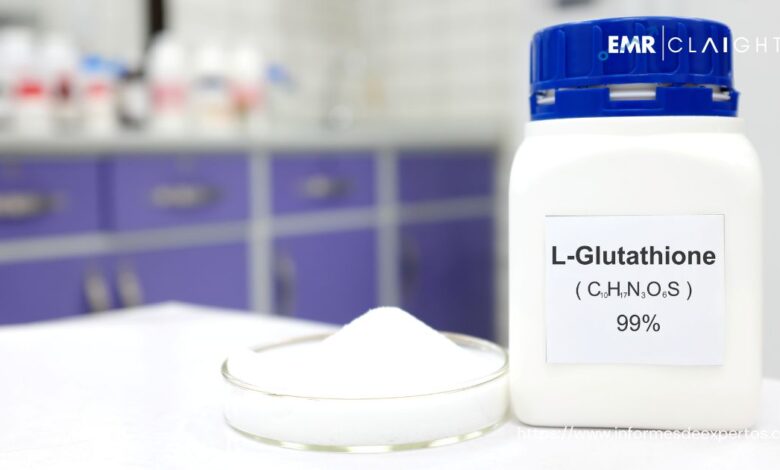Glutathione Market: Production, Applications, and Future Trends


The glutathione market refers to the global trade and consumption patterns of glutathione, a tripeptide molecule composed of glutamate, cysteine, and glycine. Known for its potent antioxidant properties and critical role in detoxification within the human body, glutathione has gained significant attention in both medical and cosmetic industries.
Production and Sources
Glutathione can be synthesized within the human body and is also found in various natural food sources such as fruits, vegetables, and meats. However, due to its therapeutic and cosmetic applications, commercial production of glutathione involves extraction from natural sources or chemical synthesis in controlled laboratory environments. The primary sources of commercial glutathione include microbial fermentation, chemical synthesis, and extraction from natural sources like yeast.
Applications
Medical and Therapeutic Applications
In the medical field, glutathione is widely recognized for its antioxidant properties and its role in supporting cellular health. It is utilized in the treatment of various conditions, including liver diseases, oxidative stress-related disorders, and as an adjunct therapy in cancer treatment to mitigate side effects of chemotherapy. The antioxidant nature of glutathione also makes it beneficial in promoting overall wellness and immune system support.
Cosmetic and Dermatological Applications
Glutathione has gained popularity in the cosmetic industry for its skin-lightening and anti-aging effects. It is used in skincare products, particularly in creams, serums, and oral supplements, aiming to brighten skin tone, reduce hyperpigmentation, and improve skin elasticity. Additionally, glutathione is administered intravenously or topically in clinical settings for dermatological treatments to achieve more even skin tone and reduce the appearance of blemishes.
Market Dynamics
The global market for glutathione is influenced by several factors, including:
- Increasing Demand: Growing awareness of health benefits and cosmetic advantages is expanding the consumer base for glutathione products worldwide.
- Technological Advancements: Advances in biotechnology and pharmaceutical manufacturing processes contribute to the development of more efficient production methods and formulations of glutathione products.
- Regulatory Landscape: Regulatory frameworks governing the production, labeling, and marketing of glutathione products vary across regions, impacting market accessibility and product availability.
Regional Insights
Asia-Pacific region, particularly countries like Japan, China, and South Korea, represents a significant market for glutathione due to its widespread use in skincare and dermatological treatments. North America and Europe also contribute to the market growth, driven by increasing consumer interest in wellness products and anti-aging solutions.
Challenges and Future Outlook
Despite its benefits, challenges such as stability issues in formulation, high manufacturing costs, and variations in efficacy among individuals pose constraints to the market growth. However, ongoing research into novel delivery systems and formulations aims to address these challenges and expand the applications of glutathione in both medical and cosmetic domains.
Production Methods
Glutathione production methods vary depending on the intended use and market demand:
- Microbial Fermentation: This method involves using genetically engineered microorganisms such as bacteria and yeast to produce glutathione through fermentation processes. It is a preferred method for large-scale production due to its efficiency and relatively low cost.
- Chemical Synthesis: Glutathione can also be synthesized chemically in laboratories, although this method is less common for commercial production due to higher costs and environmental considerations.
- Natural Extraction: Glutathione can be extracted from natural sources such as yeast or plant materials. Extraction methods involve purification steps to obtain high-purity glutathione suitable for pharmaceutical and cosmetic applications.
Market Segmentation
The glutathione market can be segmented based on application and end-use industries:
- Pharmaceuticals: Glutathione is used in pharmaceutical formulations for its therapeutic properties, including its role in detoxification and cellular protection. It is incorporated into drugs and dietary supplements targeting liver health, immune support, and chronic diseases.
- Cosmetics: In the cosmetics industry, glutathione is utilized in skincare products aimed at skin brightening, anti-aging, and complexion enhancement. Topical formulations and oral supplements are popular choices for consumers seeking to achieve a more even skin tone and reduce signs of aging.
- Food and Beverages: Glutathione is sometimes added to functional food and beverage products for its antioxidant benefits, although its use in this segment is less common compared to pharmaceuticals and cosmetics.
Future Trends
Looking ahead, the glutathione market is expected to witness several trends:
- Technological Innovations: Advances in delivery systems and formulation technologies to enhance the stability, bioavailability, and efficacy of glutathione products.
- Personalized Medicine: Growing interest in personalized healthcare solutions, including tailored formulations of glutathione based on individual health needs.
- Natural and Organic Trends: Increasing preference for natural and organic ingredients in skincare and wellness products, driving demand for natural-source glutathione.
- Market Expansion: Geographical expansion into emerging markets with rising disposable incomes and increasing health awareness.




